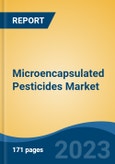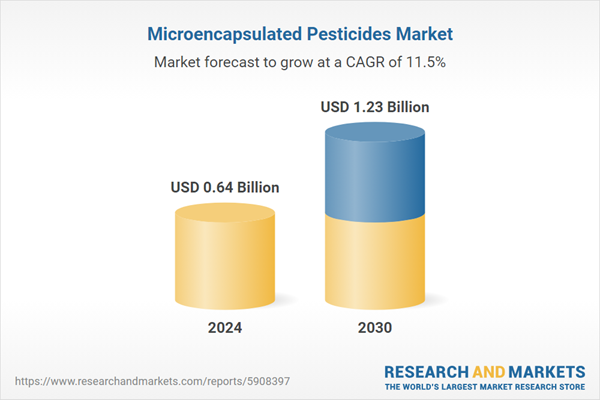Speak directly to the analyst to clarify any post sales queries you may have.
10% Free customizationThis report comes with 10% free customization, enabling you to add data that meets your specific business needs.
Compared to conventional liquid insecticides, microencapsulation has shown benefits such as reduced odor, precise dosage, and increased safety. The cost of microencapsulation may vary depending on the technology employed, which directly affects the cost of the encapsulated capsules. The demand for microencapsulated pesticides continues to grow as the agriculture industry expands, driven by shifting consumer preferences towards healthy, organic, and vegan meals that require increased crop production. Microencapsulated pesticides find utility in industrial, institutional, and residential applications due to their ability to eliminate odor and release pesticides in controlled amounts over an extended period.
Key Market Drivers
Growing Awareness About the Benefits of Microencapsulated Pesticides
Awareness of microencapsulated pesticides is rising rapidly among farmers and agricultural stakeholders. In 2024, approximately 56% of large-scale growers in Europe and North America reported using encapsulated formulations rather than conventional sprays, citing improved safety and reduced operator exposure. These formulations minimize contact with active ingredients, significantly reducing risks of skin and respiratory irritation. The protective coating also limits volatile emissions, making pesticide application safer for both workers and surrounding communities. As awareness spreads, adoption continues to expand in both advanced and emerging farming regions.Education campaigns and extension services have boosted adoption rates, with over 48% of agricultural extension programs globally now including training on encapsulated pesticide use. These efforts highlight advantages such as precise dosing and extended efficacy. Controlled-release properties allow gradual pesticide deployment, reducing required application frequency and labor inputs. This appeals especially to resource-constrained growers and those seeking compliance with environmental regulations. As more growers see tangible operational efficiencies and health benefits, acceptance of microencapsulated pesticides continues to grow steadily.
Environmental advantages are a key driver of rising awareness. Recent field trials show microencapsulated pesticides reduce off-target drift by up to 60% compared to liquid formulations, protecting surrounding flora and fauna. By curbing pesticide runoff and volatilization, these systems preserve biodiversity and minimize contamination of water bodies. They also slow degradation under UV and moisture exposure, maintaining efficacy longer and reducing waste. These measurable environmental benefits are becoming widely accepted in sustainability-focused farming communities and regulatory bodies, strengthening demand for encapsulated technologies.
Increasing regulatory scrutiny on conventional pesticide use is further fueling interest. As policymakers impose stricter restrictions on drift and residues, microencapsulation is seen as a compliant, safer alternative. Its efficiency and lower ecological footprint align well with integrated pest management and organic farming standards. Farmers adopting encapsulated formulations are often eligible for subsidy schemes or certification incentives, enhancing marketability. With greater exposure to real-world successes - such as reduced application frequency and improved worker safety - both commercial growers and institutional purchasers are increasingly choosing microencapsulated pesticides to meet modern agricultural and environmental goals.
Key Market Challenges
Increasing Stringent Regulations
The global demand for microencapsulated pesticides is anticipated to decrease due to increasingly stringent regulations being imposed worldwide. These regulations are driven by a growing awareness of the potential environmental and health impacts of these pesticides. Microencapsulation is a process that encases pesticides in tiny capsules, which are then mixed with water and sprayed on crops.While this method has been lauded for its effectiveness in controlling pests, concerns have arisen over its potential for water contamination, as the tiny pesticide capsules can often be carried away by rain or irrigation water. Additionally, there are worries about the long-term effects of these pesticides on non-target organisms, as well as the possibility of pests developing resistance to these chemicals. As a result, regulatory bodies around the world are tightening the rules regarding the use of microencapsulated pesticides. This, in turn, is expected to lower their global demand as manufacturers and farmers look for safer and more environmentally friendly alternatives.
Key Market Trends
Advancements in Targeted Pest Control
Advancements in targeted pest control techniques are anticipated to escalate the global demand for microencapsulated pesticides. By confining pesticides to tiny, biodegradable capsules, microencapsulation allows for a targeted, controlled release of the pesticide, minimizing environmental impact and increasing the effectiveness of pest management strategies. This innovative approach enhances pest control precision, reduces unintended exposure for non-target organisms, and mitigates potential health risks for humans. As global farming practises increasingly prioritize sustainable, efficient pest control strategies, microencapsulated pesticides are forecasted to gain significant traction.The adoption of these advanced products can provide effective, longer-lasting protection against pests, while reducing the overall usage of harmful chemicals. Additionally, microencapsulation technology supports the incorporation of smart, sensor-based applications in pest control, offering farmers real-time data on pest activities and pesticide performance. These benefits, combined with increasing governmental support for environmentally-friendly farming practises and the continuing technological evolution in the pest control industry, are predicted to drive the worldwide demand for microencapsulated pesticides.
Key Market Players
- Bayer AG
- BASF SE
- ADAMA Agricultural Solutions Ltd.
- FMC Corporation
- Syngenta AG
- Yara International ASA
- Sumitomo Chemical Co., Ltd.
- Israel Chemical Company Group Ltd.
- Nufarm Limited
- Botanocap
Report Scope:
In this report, the Global Microencapsulated Pesticides Market has been segmented into the following categories, in addition to the industry trends which have also been detailed below:Microencapsulated Pesticides Market, By Type:
- Herbicides
- Insecticides
- Fungicides
- Rodenticides
- Others
Microencapsulated Pesticides Market, By Technology:
- Physical
- Physico-chemical
- Chemical
Microencapsulated Pesticides Market, By Application:
- Agricultural
- Non-agricultural
Microencapsulated Pesticides Market, By Region:
- North America
- United States
- Canada
- Mexico
- Europe
- France
- United Kingdom
- Italy
- Germany
- Spain
- Asia-Pacific
- China
- India
- Japan
- Australia
- South Korea
- South America
- Brazil
- Argentina
- Colombia
- Middle East & Africa
- South Africa
- Saudi Arabia
- UAE
Competitive Landscape
Company Profiles: Detailed analysis of the major companies present in the Global Microencapsulated Pesticides Market.Available Customizations:
With the given market data, the publisher offers customizations according to a company's specific needs. The following customization options are available for the report.Company Information
- Detailed analysis and profiling of additional market players (up to five).
Table of Contents
Companies Mentioned
- Bayer AG
- BASF SE
- ADAMA Agricultural Solutions Ltd.
- FMC Corporation
- Syngenta AG
- Yara International ASA
- Sumitomo Chemical Co., Ltd.
- Israel Chemical Company Group Ltd.
- Nufarm Limited
- Botanocap
Table Information
| Report Attribute | Details |
|---|---|
| No. of Pages | 180 |
| Published | August 2025 |
| Forecast Period | 2024 - 2030 |
| Estimated Market Value ( USD | $ 0.64 Billion |
| Forecasted Market Value ( USD | $ 1.23 Billion |
| Compound Annual Growth Rate | 11.4% |
| Regions Covered | Global |
| No. of Companies Mentioned | 10 |









